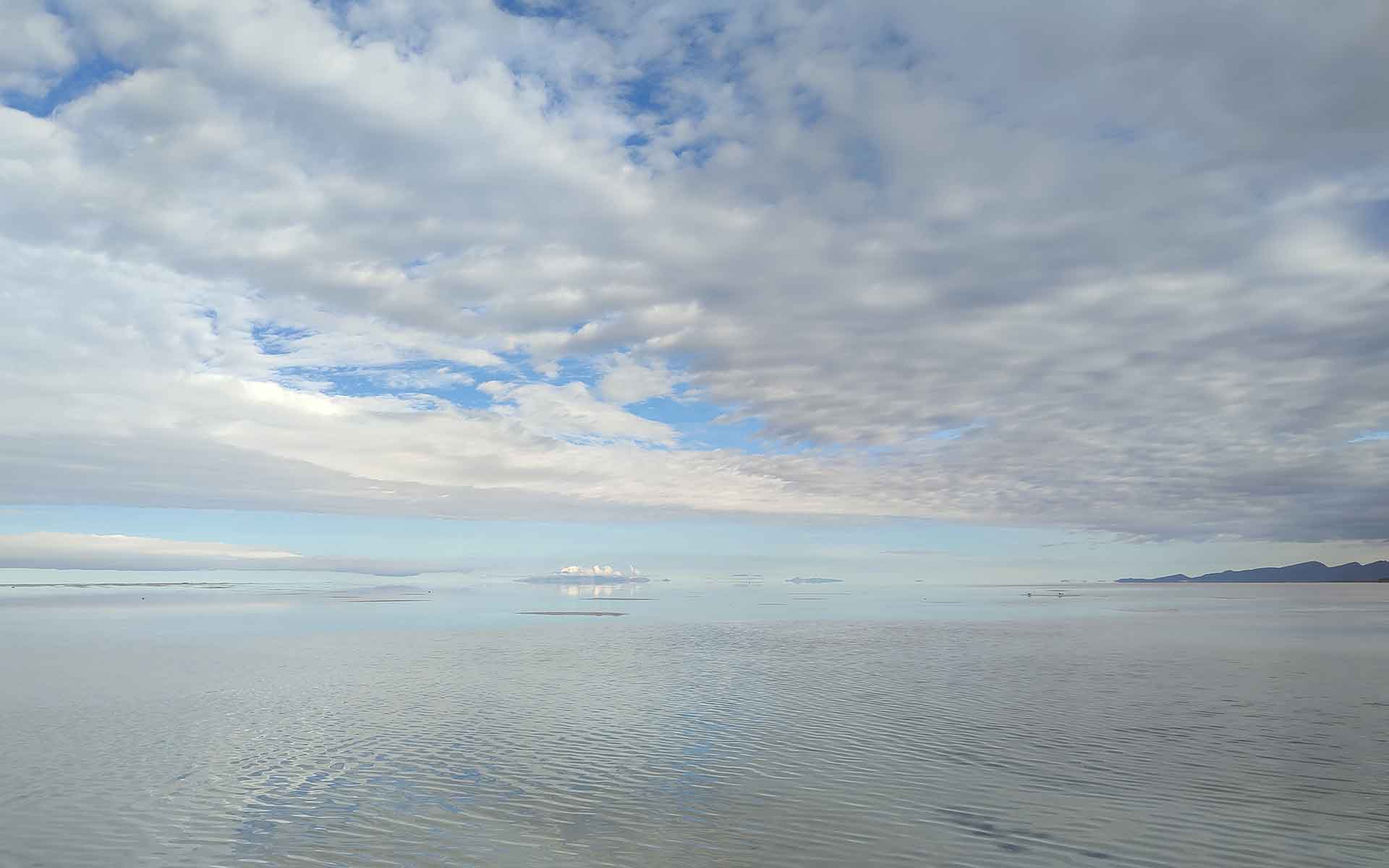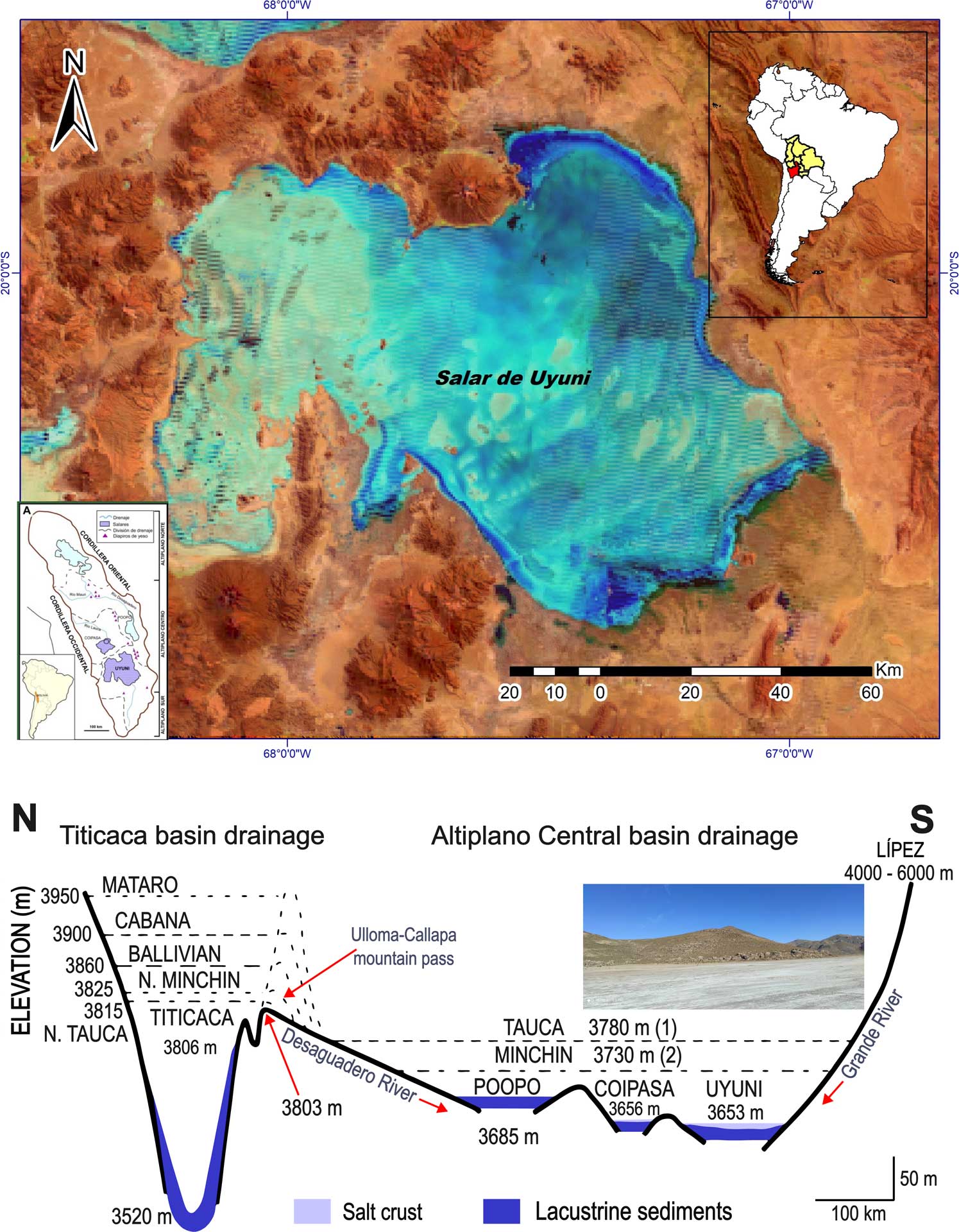
Hexagonal cracks from evaporation on Uyuni salt flat; Tunupa Volcano at the bottom.
Geological Period
Pleistocene to Holocene
Main geological interest
Stratigraphy and sedimentology
Geomorphology and active geological processes
Location
Potosí, southwest of Bolivia, Bolivia
20°11’02”S, 067°36’16”W
Hexagonal cracks from evaporation on Uyuni salt flat; Tunupa Volcano at the bottom.
The world's largest and highest extensive evaporitic deposit with the greatest reserves of lithium brines.
Holocene Uyuni Salt Flat contains the largest evaporite deposits in the world and records the climatic evolution of the Pleistocene lake during the Quaternary of the Andean Altiplano. That it is accessible and scenic at any season of the year has made this salt flat a world class tourist attraction. The endorheic basin of the Altiplano, dry and desert where evaporation is greatest, has a depth of 460 meters (Carvajal, 2018). The world’s largest salt flat, where the earth and sky are one and the same, holds a world class deposit of evaporitic Lithium and Magnesium brines.
- Geological description
Located in the highlands of the Andes, the Uyuni Salt Flat is a result of the evaporation of Tauca paleolake. The Altiplano is an extensive endorheic mountain basin of the Andes located in the volcanic arc and the Eastern Mountain Range of the Andes. It is characterized by an arid climate. During the Pleistoscene, glacial and interglacial episodes gave rise to different lake systems. During of the thawing of Choqueyapu II, Lake Tauca formed 12,500 to 10,000 years ago (Servant and Fontes, 1978).
Uyuni Salt Flat is the largest salt crust in the world that comes from the drying of the Tauca paleolake, a sacred lake that covered the southern Altiplano more than 10.000 years ago. It consists of an alternating sequence of the highly porous saline layers, composed mainly of halite, and clay-rich lacustrine sediments (Sieland, 2014), which are the source of the globally important lithium reserves (Quezada and Carvajal, 2022). The halite deposits are associated with diapirs, previous salt crusts and the dilute waters of the Altiplano (Risacher and Fritz, 1995).
The Pleistocene to Holocene evolution the lake resulted in Uyuni Salt Flat, which is the largest and highest in the world and a world class example of lithium brines production.
- Scientific research and tradition
Being a reference of evaporite deposits and lithium brines, the Uyuni Salt Flat has been studied by international missions such as ORSTOM to understand the origin and geological, hydrogeological and geochemical characteristics, mainly through drilling. The United States Geological Survey considers the Uyuni Salt Flat to hold one of the largest lithium deposits in the world.
- Reference
Quezada Cortez, G. and Carvajal Velasco, N. (2022) El Salar de Uyuni: El depósito evaporítico más grande del mundo. Available at: https://gmga.com.br/06-salar-de-uyuni-el-deposito-evaporitico-mas-grande-del-mundo/.
Risacher, F. and Fritz, B. (1991) ‘Quaternary geochemical evolution of the salars of Uyuni and Coipasa, Central Altiplano, Bolivia’, Chemical Geology, 90(3), pp. 211–231. Available at: https://doi.org/10.1016/0009-2541(91)90101-V.
Risacher, F. and Fritz, B. (1995) ‘Evolucion cuaternaria del salar de Uyuni, Altiplano central, Bolivia.’, in P. Ribstein and B. Francou (eds) Aguas, glaciares y cambios climaticos en los Andes tropicales : conferencias y posters. Aguas, Glaciares y Cambios Climaticos en los Andes Tropicales; Seminario Internacional, La Paz, Bolivia: ORSTOM, pp. 281–282.
Servant, M. and Fontes, J. (1978) ‘Les lacs quaternaires des hauts plateaux des Andes boliviennes: Premieres interpretation paleoclimatiques’, Cahiers ORSTOM. Serie Geologie, 10(1), pp. 9–23.
Sieland, R. (2014) Hydraulic Investigations of the Salar de Uyuni, Bolivia, FOG – Freiberg Online Geoscience. Thesis. FOG – Freiberg Online Geoscience. Available at: https://www.researchgate.net/publication/281061345_Hydraulic_Investigations_of_the_Salar_de_Uyuni_Bolivia.
U.S. Geological Survey (2020) Mineral Commodity Summaries. U.S. Geological Survey, p. 200. Available at: https://doi.org/10.3133/mcs2020.
- Author(s)
Wilfredo Ramos Collorana.
Universidad Mayor de San Andrés, Ingeniería Geológica, IGEMA. Bolivia.
Nelson Roman Carvajal Velasco.
YLB. Bolivia.
Luis Mario Jimenez Huanca.
Independiente. Bolivia.


